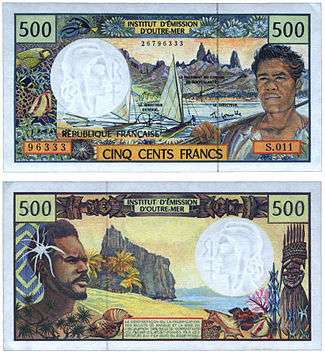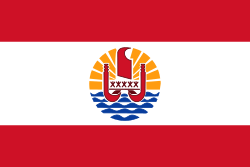CFP franc
The CFP franc (called the franc in everyday use) is the currency used in the French overseas collectivities (collectivités d’outre-mer, or COM) of French Polynesia, New Caledonia and Wallis and Futuna. The initials CFP originally stood for Colonies Françaises du Pacifique (‘French colonies of the Pacific’). This was later changed to Communauté Financière du Pacifique (’Pacific Financial Community’) and then to its present term, Change Franc Pacifique (“Pacific Franc Exchange”). Its ISO 4217 currency code is XPF.
| CFP franc | |
|---|---|
| franc pacifique (French) | |
 500F banknote | |
| ISO 4217 | |
| Code | XPF |
| Number | 953 |
| Exponent | 0 |
| Denominations | |
| Symbol | F |
| Banknotes | 500, 1000, 5000, 10,000 Francs CFP |
| Coins | 1, 2, 5, 10, 20, 50, 100 Francs |
| Demographics | |
| User(s) | |
| Issuance | |
| Central bank | Institut d’émission d’Outre-Mer (IEOM) |
| Website | www |
| Valuation | |
| Inflation | 0% (French Polynesia 2015 est.), 1.9% (New Caledonia 2017 est.) |
| Source | The World Factbook |
| Pegged with | 1 000 XPF = 8.38 EUR |
History
1945–1949
The CFP franc was created in December 1945, together with the CFA franc, used in Africa. The reason for the creation of these francs was the weakness of the French franc immediately after the Second World War. When France ratified the Bretton Woods Agreement in December 1945, the French franc was devalued in order to set a fixed exchange rate with the US dollar. New currencies were created in the French colonies to spare them the strong devaluation of December 1945. René Pleven, the French minister of finance, was quoted saying: “In a show of her generosity and selflessness, metropolitan France, wishing not to impose on her far-away daughters the consequences of her own poverty, is setting different exchange rates for their currency.” The other French colonial currencies were set at a fixed exchange rate with the French franc. However, the CFP franc was set at a fixed exchange rate with the US dollar, which played a major role in the economy of the French Pacific territories on account of World War II. That situation ended in September 1949 when the CFP franc was given a fixed exchange rate with the French franc.
1949–1985
The CFP franc has been issued by the IEOM (Institut d’émission d’outre-mer, “Overseas Issuing Institute”) since 1967. The IEOM has its headquarters in Paris.
The currency was initially issued in three distinct forms for French Polynesia, New Caledonia and the New Hebrides. (See French Polynesian franc, New Caledonian franc and New Hebrides franc.) Wallis and Futuna used the New Caledonian franc. Although the banknotes of the New Hebrides bore the name of the territory, the notes of French Polynesia and New Caledonia could only be distinguished by the name of the capitals (Papeete and Nouméa, respectively) on the reverse of the notes.
In 1969, the New Hebrides franc was separated from the CFP franc and was replaced by the Vanuatu vatu in 1982.
Since 1985

The new highest denomination 10,000 CFP franc banknote (€83.80) issued on 1 October 1986, was the first one that was not overprinted with a city name. The 500 franc banknote, issued in 1992, and the 1000 and 5000 franc banknotes, issued in 1995, are also without the overprint. The designs of the 500, 1000, 5000 franc banknotes did not change until 2014, when new designs and sizes were introduced.
Today, all banknotes are strictly identical from New Caledonia to French Polynesia. One side of the banknotes shows landscapes or historical figures of French Polynesia, while the other side of the banknotes shows landscapes or historical figures of New Caledonia.
The coins are still separated in two sets: one side of the coins is identical from New Caledonia to French Polynesia, while the other side of the coins is inscribed with the name Nouvelle-Calédonie in New Caledonia and in Wallis and Futuna, and with the name Polynésie française in French Polynesia. Both sets of coins can be used in all three French territories. The situation of the CFP coins is thus quite similar to that of the euro coins, which have a national side but can be used in all countries of the eurozone.
Historical exchange rates
- December 26, 1945 to September 20, 1949 – Fixed exchange with the US dollar at 1 USD = 49.6 XPF. Non-fixed exchange rate with the old French franc, which devalued four times vs. the US dollar. From 1 XPF = 2.40 FRF (FRF = French franc) in December 1945, the exchange rate reached 1 XPF = 5.50 FRF in September 1949.
- September 21, 1949 to December 31, 1959 – Fixed exchange rate with the old French franc at 1 XPF = 5.50 FRF
- January 1, 1960 to December 31, 1998 – Fixed exchange rate with the French franc at 1 XPF = 0.055 FRF or 1 FRF ≈ 18.182 XPF (January 1, 1960: 100 'old' francs became 1 'new' franc)
- January 1, 1999 onward – Fixed exchange rate with the euro at 1,000 XPF = 8.38 EUR or 1 EUR ≈ 119.332 XPF (January 1, 1999: euro replaced FRF at the rate of 6.55957 FRF for 1 euro)
- The calculation to the euro was , which meant that 1000 XPF was not worth exactly €8.38 prior to the introduction of the euro. The value of 1000 XPF in euros was instead rounded to the nearest euro cent upon the introduction of the euro.
The 1960 and 1999 events are merely changes in the currency in use in France; the relative value of the CFP franc (XPF) vs. the French franc / euro is unchanged since 1949.
Coins
In 1949, New Caledonia and what was then called French Oceania (now French Polynesia) began to issue coins. The coins have been separated in two types: the obverses are identical, whilst the reverses are distinct. Both types of coins can be used in all three French territories. The situation of the CFP coins is thus quite similar to that of the euro coins, which have a national side but can be used in all countries of the euro zone.
The New Hebrides franc had a different history of coin issuance before being replaced by the Vanuatu vatu in 1982.
The IEOM circulates in the French Pacific Colonies have two sets of metal coins with a face value of 100, 50, 20, 5, 2, and 1 XPF. The first series runs mainly in New Caledonia and Wallis and Futuna, the second in French Polynesia, although both series have distinct legal tender in each of the regions.
Each piece – consisting of copper, nickel, magnesium or aluminum – is designed by: first an obverse depicting a landscape, a fruit, an animal or a sculptural typical of the area, the name of the territory associated with the series, and the denomination on the other hand a reverse contained an allegorical representation (Minerva, goddess of wisdom or portrait of Marianne, symbol of the Republic), the initials of the bank issuing central (IEOM), the vintage (corresponding to the year of manufacture) and the words "French Republic" with a slight of the aspect is smooth or fluted.
Values 1, 2, and 5 Francs have aluminum and magnesium in both sets. 10, 20, and 50 Francs only have a nickel composition, meaning it was completely made of nickel until 2005, then copper nickel. The 100 Franc was made of nickel bronze until 2005, and from 2006 copper, nickel, and aluminum.
| French Polynesian Coins | ||||||||||
|---|---|---|---|---|---|---|---|---|---|---|
| Image | Value | Technical parameters | Description | Common name | ||||||
| Obverse | Reverse | Diameter | Thickness | Mass | Composition | Edge | Obverse | Reverse | ||
| Franc | 23 mm | 1.3g | Aluminum Magnesium |
Plain | Minerva | Coast of French Polynesia Kagu Bird |
Franc | |||
| Two Francs | 27 mm | 2.2g | Two Franc | |||||||
| Five Francs | 31 mm | 3.5g | Five Francs | |||||||
| Ten Francs | 24 mm | 6g | 100% Nickel to 2005 Copper-Nickel after 2006 |
Milled | Marianne | Tiki Seascape |
10 Francs | |||
| 20 Francs | 28.5 mm | 10g | Breadfruit (Artocarpus altilis) Zebu |
20 Francs | ||||||
| 50 Francs | 33 mm |
15g | Coastal Scenery with House Hut with Pine |
50 Francs | ||||||
| 100 Francs | 30 mm | 10g | Nickel Copper Aluminum |
100 Francs | ||||||
| These images are to scale at 2.5 pixels per millimetre. For table standards, see the coin specification table. | ||||||||||
Banknotes
The IEOM began issuing banknotes in New Hebrides in 1965, and in New Caledonia and French Polynesia in 1969. On 1 October 1986, a new banknote, the 10,000 francs, was introduced which did not bear any distinguishing mark and was common to both French Polynesia and New Caledonia.[1] These were followed, between 1992 and 1995, by 500, 1000 and 5000 franc notes for all of the French Pacific Territories.
The overall design has not changed since 1969. One side shows landscapes or historical figures of New Caledonia, while the other side of the banknotes shows landscapes or historical figures of French Polynesia.
On January 6, 2014, the IEOM unveiled designs for a new series of banknotes. The new notes were issued on January 20. The older issues ceased circulation on September 30 of that year, but can be exchanged indefinitely at the Institut d’Emission d’Outre-Mer offices.[2][3][4]
Tārā
Before the French regulated the currency on Tahiti, French Polynesia, traders often used dollars. The word “dollar” became tārā (often written without accents as tara, or tala), and this term is still used among native Tahitian and local Chinese traders as an unofficial unit, worth 5 francs. Thus for a price of 200 francs, one would say tārā e maha-ʻahuru (40 tārā) in Tahitian. The currency of Samoa is also called the tālā.
| Current XPF exchange rates | |
|---|---|
| From Google Finance: | AUD CAD CHF EUR GBP HKD JPY USD NZD |
| From Yahoo! Finance: | AUD CAD CHF EUR GBP HKD JPY USD NZD |
| From XE.com: | AUD CAD CHF EUR GBP HKD JPY USD NZD |
| From OANDA: | AUD CAD CHF EUR GBP HKD JPY USD NZD |
| From fxtop.com: | AUD CAD CHF EUR GBP HKD JPY USD NZD |
See also
- CFA franc
- Currencies related to the euro
- French Polynesian franc
- Monetary union
- New Caledonian franc
- New Hebrides franc
References
- Linzmayer, Owen (2012). "French Pacific Territories". The Banknote Book. San Francisco, CA: www.BanknoteNews.com.
- French Pacific Territories new notes to be introduced 20.01.2014 BanknoteNews.com. October 22, 2013. Retrieved on 2013-10-23.
- Official website for the new banknotes of the French Pacific Territories Archived 2015-11-04 at the Wayback Machine Institut d’Emission d’Outre-Mer (www.ieom.fr). Retrieved on 2013-10-23.
- French Pacific Territories new 2014 note family confirmed BanknoteNews.com. February 3, 2014. Retrieved on 2014-02-04.
- Krause, Chester L.; Clifford Mishler (1991). Standard Catalog of World Coins: 1801–1991 (18th ed.). Krause Publications. ISBN 0873411501.
- Pick, Albert (1994). Standard Catalog of World Paper Money: General Issues. Colin R. Bruce II and Neil Shafer (editors) (7th ed.). Krause Publications. ISBN 0-87341-207-9.
